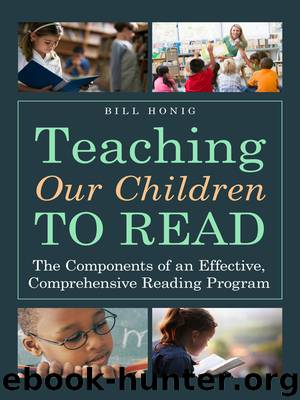Teaching Our Children to Read by Bill Honig

Author:Bill Honig
Language: eng
Format: epub
Publisher: Skyhorse Publishing
Published: 2014-03-14T16:00:00+00:00
The Importance of Timely, Early Intervention
During the past decade, schools have paid increasing attention to programs that provide rapid and early intervention or tutoring strategies for those students who are already slipping in the first grade because they are so deficient in skills. A successful reading program must have a strand that deals with this problem.
The best way to minimize the need for later remediation is to have good teaching in an organized program, clear benchmarks and interventions, and special support for those students who need additional help. (For critical literacy benchmarks, see Chapter 7.) In the early grades, frequent, ongoing assessment is crucial to pinpoint students’ areas of strength and weakness and to guide decisions about grouping, pace, and intervention. There are several critical benchmarks during these years, including identifying the first sound in spoken words by mid-kindergarten, identifying the final and middle sounds by late kindergarten, and decoding simple CVC words by mid-first grade.
For struggling readers in the upper grades, assessment should pinpoint what is impairing their progress. If they do poorly on silent reading comprehension, they should be given a 1-minute timed oral reading fluency test. If students do well on the test, they would probably benefit from systematic instruction in comprehension strategies and may need testing to determine any gaps in vocabulary knowledge. If they perform below grade level in fluency, the next questions to ask are, “Is decoding a problem?” and “How much alphabetic knowledge does the student have?” Student performance on the CORE Phonics Survey (CORE, 1999a) points to four different levels of needed instruction. Some students can decode all of the single-syllable and multisyllabic words and are, therefore, ready to develop their strategic reading skills through independent reading of increasingly complex material. A large number of students do well decoding the single-syllable words on the test but have difficulty with the section on multisyllabic words. They benefit from several weeks of directed instruction in common syllable types and their division patterns—breaking words with two consonants in the middle between the consonants VC/CV (kid•nap) and reading words with the VCV pattern (which can break before or after the consonant) in the most typical way (V/CV with a long-vowel sound) and then using context to confirm pronunciation (de•pend). Another large group of students can only read words with simple linguistic patterns (e.g., CVC and CCVC words with short vowels and words with the VCe long-vowel pattern) but need directed instruction in the more complex vowel patterns and connected reading and writing practice. A fourth group is extremely confused and cannot read even basic CVC words. These students require further assessment to determine the cause of their difficulties and subsequent intervention in phonics and, if indicated, phonemic awareness.
Download
This site does not store any files on its server. We only index and link to content provided by other sites. Please contact the content providers to delete copyright contents if any and email us, we'll remove relevant links or contents immediately.
| Arts & Humanities | Health |
| Language Arts | Library Skills |
| Mathematics | Reading & Phonics |
| Science & Technology | Social Studies |
The Art of Coaching Workbook by Elena Aguilar(48064)
Trainspotting by Irvine Welsh(20055)
Twilight of the Idols With the Antichrist and Ecce Homo by Friedrich Nietzsche(17705)
Fangirl by Rainbow Rowell(7834)
Periodization Training for Sports by Tudor Bompa(7328)
Change Your Questions, Change Your Life by Marilee Adams(6641)
This Is How You Lose Her by Junot Diaz(5771)
Grit by Angela Duckworth(4736)
Red Sparrow by Jason Matthews(4666)
Asking the Right Questions: A Guide to Critical Thinking by M. Neil Browne & Stuart M. Keeley(4574)
Paper Towns by Green John(4169)
Room 212 by Kate Stewart(4107)
Ken Follett - World without end by Ken Follett(3972)
The Sports Rules Book by Human Kinetics(3588)
Housekeeping by Marilynne Robinson(3401)
The Motorcycle Diaries by Ernesto Che Guevara(3332)
Introduction to Kinesiology by Shirl J. Hoffman(3299)
Exercise Technique Manual for Resistance Training by National Strength & Conditioning Association(3291)
Double Down (Diary of a Wimpy Kid Book 11) by Jeff Kinney(3272)
